
|
 |
|
You probably know the difference between a bull and a bear market. But what about the difference between a call and a put? A trend line and a trend break? Whisper numbers and whipsaws? Get the answers in our online glossary. Excerpted with permission from Getting Started in Online Trading, by David L. Brown and Kassandra Bentley (New York: John Wiley & Sons, 1999). H | I | L | M | N | O | P Q | R | S | T | U | W back-end load - the sales commission on mutual fund transactions that is charged at the time of redemption or sale, rather than at the time of purchase. The latter is a front-end load. bank-sponsored plans - a direct stock purchase plan (DSP) or dividend reinvestment plan (DRIP) that is administered by a bank rather than the company itself. bond swaps - a municipal bond investment strategy that lets you take a tax loss and adjust your bond portfolio for credit quality and maturities to meet market considerations and your personal needs. breakout - a change in a technical indicator that generates a change in the trading signal, from a hold to a buy or sell, from a buy to a sell, or from a sell to a buy. call - an option contract that gives the holder the right to buy the underlying security at a specific price for a specific period of time. Calls can be bought or sold.  contrarian strategy - an investing strategy that
appears to go against the mood of the market, buying heavily
during sluggish, pessimistic markets and selling during
periods of market optimism.
contrarian strategy - an investing strategy that
appears to go against the mood of the market, buying heavily
during sluggish, pessimistic markets and selling during
periods of market optimism.country fund - a closed-end mutual fund which invests its assets in the securities of companies within a given country (e.g., the Thailand Fund). covered call - a call option written by a person who owns the underlying security. day order - an order to buy or sell a security that expires at the end of the day. day trading - the practice of basing trades on market fluctuations during the day and closing out positions by the end of the trading day. delayed quotes - stock quotes that are delayed by the exchanges 15 or 20 minutes from real-time. DIP see direct investment plan direct enrollment - a dividend reinvestment plan that allows an individual to purchase stock directly from the company. direct investment plan (DIP) - allows an individual to buy shares directly from a company. Also called a direct stock purchase plan (DSP). direct public offering (DPO) - an initial public offering that bypasses the traditional underwriter and offers shares directly to the public over the Internet. Also called an online stock offering. direct stock plan (DSP) - see direct investment plan (DIP) dividend reinvestment plan (DRIP) - this plan automatically purchases a company's stock with a shareholder's dividends from that stock. dollar-cost averaging - a system of investing a fixed sum at regular intervals in stocks or mutual funds. Acquiring more shares at lower prices and fewer shares at higher prices helps minimize your market risks. 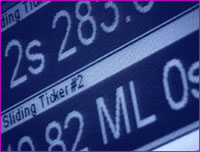 Dow dividend approach - an investing strategy that
invests equally in the 10 stocks of the Dow 30 that pay the
highest dividends.
Dow dividend approach - an investing strategy that
invests equally in the 10 stocks of the Dow 30 that pay the
highest dividends. DRIP - see dividend reinvestment plan DRP - see DRIP DSP - see DIP exponential moving average - a moving average smooths the fluctuations in stock prices by averaging the prices over a specified period. An exponential moving average gives heavier weight to the most recent data. fundamental analysis- evaluating a stock by assessing a company's intrinsic worth and growth potential based on such factors as historical earnings, projected earnings, revenues, cash flow, and various financial ratios. fundamentals - factors that contribute to a company's basic financial health, such as earnings, revenues, cash flow, debt level, and financial ratios. futures contract - a contract that allows an investor to buy or sell a security that is good until it is either filled or cancelled. hard stop - a stop order issued to a broker to sell a stock should it reach a specified price. in play - refers to a stock that is known to be a candidate for a takeover or merger, which often throws it into a public bidding contest between two or more suitors. intraday chart - a price-and-volume stock chart that tracks the minute-by-minute trades during the day. 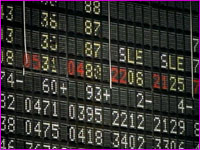 limit order - an order to buy or sell
securities at a specific price or better.
limit order - an order to buy or sell
securities at a specific price or better. load - the sales commission charged by mutual funds on share transactions. A front-end load is a commission charged on purchases; a back-end load is a commission charged on redemptions. long - refers to securities owned by an investor and held in the investor's brokerage account. LSQ line - LSQ stands for a mathematical formula called "least squares." In technical analysis, an LSQ line is a trend line that determines the midpoint of price data on a stock graph. An LSQ channel is created by drawing parallel lines on either side of the LSQ line to encompass the trading action. margin account - a brokerage account that allows investors to borrow money against their securities held by that broker. market order - an order to buy or sell a specified number of shares at the best available price. market share - the percentage of a specific market segment that is dominated or controlled by a player in that market. In the online brokerage market segment, for example, 27.4 percent of all online investors are customers of Charles Schwab & Co., while only 3.3 percent are customers of Discover Brokerage (as of the fourth quarter, 1998). market top - a point at which a long-term uptrend reverses and the market heads downward. mental stop - a reminder to reevaluate a stock if it falls to a specified level. The reminder can be a visual flag in an online portfolio or an e-mail message from the Web site that maintains the portfolio. moving average - the average of a stock price over a specified time period. A moving average smooths price and volume fluctuations and emphasizes the direction of a trend. An exponential moving average gives greater weight to the most recent price action.  moving average convergence/divergence (MACD) - a
trading method based on the crossing of two exponential moving
averages above and below a zero line. (A third moving average
plots the difference between the other two and forms a single
line.) The convergence and divergence of the moving averages
generate buy and sell signals.
moving average convergence/divergence (MACD) - a
trading method based on the crossing of two exponential moving
averages above and below a zero line. (A third moving average
plots the difference between the other two and forms a single
line.) The convergence and divergence of the moving averages
generate buy and sell signals.net asset value (NAV) - the price paid for a mutual fund share. The NAV is computed daily by summing the values of all the fund's investments, subtracting expenses and liabilities, and dividing that number by the number of outstanding shares. no-load - the absence of sales commissions, as in no-load mutual funds. option - a contract that gives the holder the right but not the obligation to buy or sell a specified quantity of a security at a specified price within a specified time. option chain - a list of all tradable options on a given stock. order flow - the buy and sell orders that brokers send to market makers often in return for cash payments. out-of-the-money - refers to an option whose strike price [the price at which an option can be exercised] is greater (if it is a call) or less (if it is a put) than the current market price of the underlying security. overbought - a condition that occurs in the market when there are more buyers than sellers and stock prices hover at a precariously high level. An overbought market is ripe for a correction. oversold - a condition that occurs in the market when there are more sellers than buyers and stock prices fall to extremely low levels. An oversold market is poised for an upward movement. partial fill - a limit order that is only partially filled because the total specified shares could not be bought or sold at the specified price. 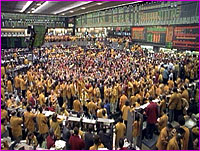 penny stocks - over-the-counter stocks that trade for
(usually) less than $3/share. Quotes are entered by dealers
who act as market makers and are printed on "Pink Sheets"
(hence the name) by the National Quotation Bureau.
penny stocks - over-the-counter stocks that trade for
(usually) less than $3/share. Quotes are entered by dealers
who act as market makers and are printed on "Pink Sheets"
(hence the name) by the National Quotation Bureau.portfolio tracker - a mechanism on the Web that can retrieve stock prices and other data for multiple securities, allowing you to track the performance and valuation of a portfolio of stocks. price-to-book ratio - a company's stock price divided by its book value. price-to-earnings ratio (P/E ratio) - a company's stock price divided by its annual earnings per share. price-to-sales ratio - a company's stock price divided by its annual sales. put - an option contract that gives the holder the right to sell the underlying security at a specific price for a specific period of time. Puts can be bought or sold. quarter-over-quarter earnings - a comparison of a company's current quarterly earnings per share with its earnings per share for the same quarter last year. real-time quotes - stock quotes that include the most recent trade, as opposed to quotes that are delayed 15 or 20 minutes by the exchanges. redemption fee - a fee charged by some mutual funds when an investor sells shares in the fund. Also called a back-end load. screen - one or more characteristics that are used as a filter to eliminate stocks that don't have those characteristics. short interest - the number of a company's shares that have been sold short and not yet repurchased, frequently reported as the number of days it would take to cover the short position, assuming the volume of stock stays at its average volume traded over the past 30 days. 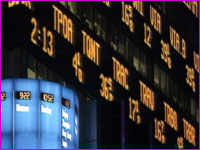 short selling - selling a security you don't own
(borrowed from your broker) with the intention of buying it at
a lower price to replace the borrowed shares. Short sellers
are betting the price will go down.
short selling - selling a security you don't own
(borrowed from your broker) with the intention of buying it at
a lower price to replace the borrowed shares. Short sellers
are betting the price will go down. spread - the gap between the bid and the ask prices of a security. stop-limit order - a variation on the stop order; a stop-limit order will be executed only at the limit price, not higher or lower than the limit price. In contrast, a stop order will be executed at the stop price, or, should the stock gap up or down, at the higher- or lower-than-stop price. stop order - an order placed at a price that is higher (a buy stop) or lower (a sell stop) than the current market price. Buy stops are used by short sellers; sell stops are employed by investors who trade long. Both are used to protect profits and limit losses. Strategic Indexing - the use of an investing strategy that has been back-tested over a long period of time and has exceeded a target index, such as the S&P 500. street name - refers to the registered holder of a security when it is held in the broker's name, rather than in the name of the person who owns the stock. support - a price level that represents a floor for falling stock prices. It is a price at which buying has historically entered, thereby tending to limit declines below this level. tick - an incremental change of a stock price. An uptick means the trade was higher than the one before; a downtick means the trade was lower than the previous level. trading bands - on a stock graph, an envelope drawn within a set distance on either side of a moving average to delineate a stock's trading range. trend break - the movement of the stock price through a trend line. A positive trend break is a move upward through a downward trend line; a negative trend break is a move downward through an upward trend line. trend line - a line on a stock graph that connects a series of highs or lows to delineate an uptrend (representing support) or a downtrend (representing resistance). underlying security - the stock, bond, index, or other financial instrument upon which a derivative such as an option is based. It is the underlying security that is subject to being bought or sold upon exercise of the option. upgrades/downgrades - analysts make buy/hold/sell recommendations for the stocks they follow. An upgrade is a change from a sell to a hold or buy, or from a hold to a buy. A downgrade is a change from a buy to a hold or sell, or from a hold to a sell. watch list - a list or portfolio of stock prospects that you are watching with an eye for an optimum entry point. whipsaws - very frequent reversals of a stock between buy and sell signals, based on various technical indicators; also called chatter. whisper numbers - figures widely believed by "those in the know" on Wall Street to be the true earnings that a company will achieve in the next quarter. The whisper numbers often exceed the earnings estimate published by analysts. When a company announces earnings that meet or even exceed the analysts' estimates but fail to meet the whisper numbers, the stock price will often drop. Photos: ©BBC. The Formula That Shook The World | Impact of Online Trading A Trader's Lexicon | Play a Virtual Market | Resources Transcript | Site Map | Trillion Dollar Bet Home Editor's Picks | Previous Sites | Join Us/E-mail | TV/Web Schedule About NOVA | Teachers | Site Map | Shop | Jobs | Search | To print PBS Online | NOVA Online | WGBH © | Updated November 2000 |
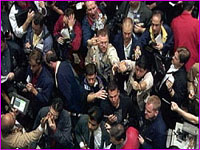 Want to sling the lingo of a stock trader? Plunge
into our online glossary of traders' terms.
Want to sling the lingo of a stock trader? Plunge
into our online glossary of traders' terms.